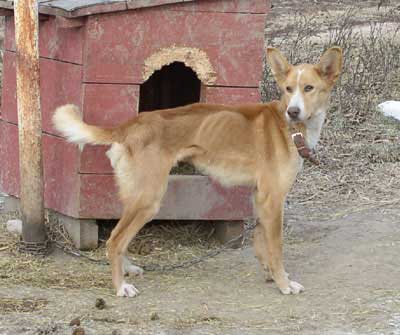
no food or water bowls.
How can you tell if a pet needs help?
Look for clues that food, water, veterinary care, shelter, or loving companionship are absent or inadequate.
Observe the pet’s condition, environment, and apparent situation, like a humane professional would. Use your critical thinking skills.
Does the Pet Need Food?
Observe the signs carefully, because some dogs are very thin despite eating enough food, especially elderly dogs and cats. Check back several days in a row at different times, to see if the food bowl is refilled. Look for several signs. A filthy, junky environment can be a clue that basic needs are not being met, also.
- Empty, missing, or overturned food bowl
- Visible ribs, bony backbone, hip bones jut out
- Weak and wobbly, too weak to stand
- Chewed wood, shrubbery
- Teeth worn down from chewing rocks
- Dirty muzzle from eating dirt
- Bad breath from eating feces
Does the Pet Need Water?
Check back several times in the next day or two at different times, to see if the water bowl is refilled, but don’t wait too long before calling police or humane professionals. Pets can’t go without water for more than several days before internal organs are affected. Look for several signs. A filthy, junky environment can be a clue that basic needs are not being met, also.
- Dry mouth and nose, sticky saliva
- Eyes, cheeks, skin are sunken and look flat
- Pinch the skin and it flattens slowly when released (skin pinch test)
- Dull, lifeless fur
- Dark yellow or amber urine
- Confusion and drowsiness
- Weak, rapid pulse
Does the Pet Need Veterinary Care?
If you see any of these signs, call police or humane professionals. For less urgent symptoms, talk to the pet owner.
- Visible injury, blood or broken bones
- Makes persistent noises of distress, such as whining, groaning, yelping, meowing
- Sneezing or coughing
- Matter running from eyes or nose
- Lower eyelids raised may indicate the presence of parasites
- Patches of fur missing, dull lifeless fur, dirty fur, matted fur
- Difficulty walking or standing
- Uninterested in surroundings
- Uninterested in food and water
- Loss of consciousness
Is the Pet Abused?
Definition of Abuse: injury or ill health caused by wrongful and inhumane treatment; intentional neglect. Look for several signs, because some pets are submissive and shy naturally, and have never been abused.
- Visible scars, wounds, or limping
- May act anxious or aggressive
- May grovel, especially when you raise an arm or leg
- May bark, growl, or whine as you approach
- May be hungry or thirsty, or show other signs of neglect
- Possibly attempts to escape containment
Does the Pet Need Adequate Shelter?
Shelter needs vary, depending on climate, the type of pet, and conditioning. Ideally, pets have solid roofed and sided shelter of ample size that protects from rain/snow, wind, sun, and extreme temperatures. Fences are strongly preferred to chains or ropes. Pets should not be allowed to roam unsupervised.
Pets with Homes
If you see any of these signs, call police or humane professionals.
- Enclosure is unsafe, with raw edges or sharp metal parts
- Bad quality shelter, filthy yard, urine and feces are present
- No shelter nearby (trees don’t count)
- Shelter is facing north or west without a windbreak in cold or wet weather
- Collar is too tight and skin under the collar is raw
- Chain is too short for a pet to stand upright, or too short to reach food and water
- Dog house door is too small for the dog to crawl inside
- Dog house, kennel, crate is too small for dog to stretch out
Stray Pets
If you see any of these signs, call police or humane professionals.
- Running loose and unsupervised, with or without a collar
- Appears to be lost, seeking a person or a vehicle
- Weather is too hot, too cold, too stormy
- Unusual location, alone along a highway, under a bridge, or in the woods
